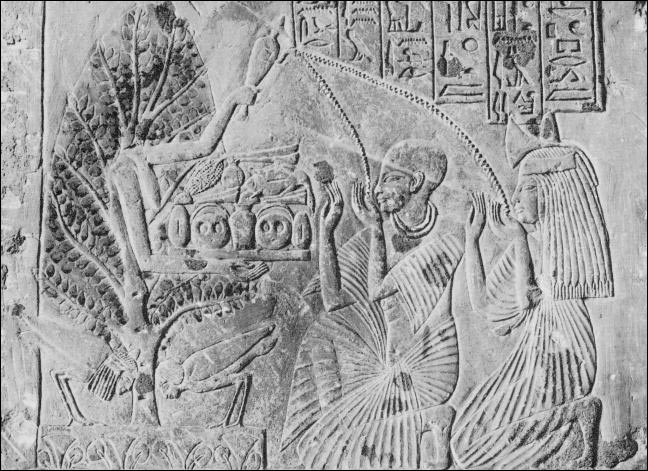Date
ca. 14th c. B.C.
Origin
The Ancient World : Egypt : New Kingdom : XVIII Dynasty : Before Amarna
Description
b) palm tree, & a) sycamore tree, laden with fruit, its human arms
presenting tray of offerings and pouring out water from ewer for benefit
of the dead; ba birds (souls) of the deceased beneath tree.
"The goddess as the tree that confers nourishment on souls, as
the sycamore or date palm, is one of the central figures of Egyptian
art." [--Neumann.] Hathor, the Lady of the Sycamore, as well as
Nut, the celestial cow goddess, were believed to be immanent in the
sycamore which offered its cool shade and its fruit to the weary. In
the tree's branches, hung a water skin, to slake thirst. Thus the tree
provided every necessity for the deceased. Here it is the date palm
(b) & sycamore (a) which performs these functions. (For a discussion
of the sycamore and tree symbolism in general in Egyptian art, see 2Ak.092.)
Neumann writes: "...the motherhood of the tree consists not only
in nourishing; it also comprises generation and the tree goddess gives
birth to the sun." See 2Ak.159 for a representation which epitomizes
this belief.
Object
Relief (limestone).
Style or School
Dynasty XVIII.
Material or Technique
Sculpture (detail).
Repository or Site
a)Hanover: Mus., Kestner.
Image Sources
b)from Neumann.* [EN:GM fig.52]
a) from Campbell.**
References
*Neumann, E., Great (1955), p.241; fig.52.
AO, XIII:4 (1912), pp.22-3; fig.19.
**Campbell, J., Mythic Image (1974), pl.241
|

